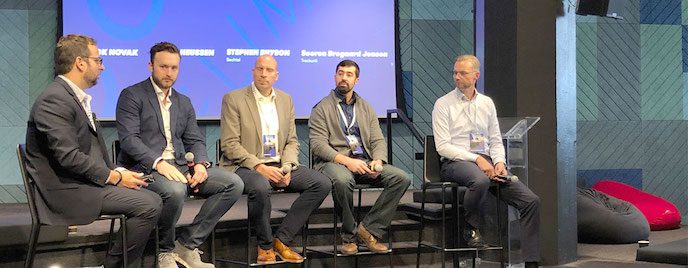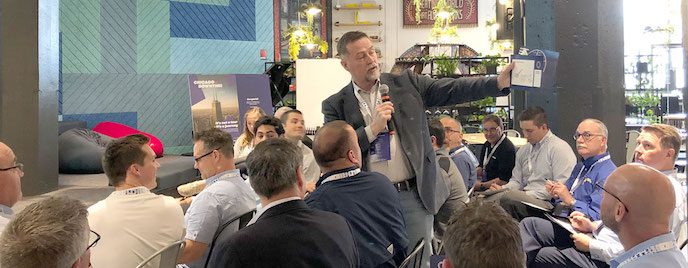

We all know that feeling when you believe you have the solution to a problem, but it seems that you are pushing against a closed door when trying to explain it to others. Telematics and the digitalization of the Construction Industry has, at times, felt like that.
However, times are changing, and with the sweep of the hands, the door is swinging open. Collaboration between equipment manufacturers customers and third-parties are creating real benefits for all. Open system development platforms are creating industry-wide conversations and are the early steps to a range of standardised solutions.

As a founding member of the Eliminate Downtime movement we have seen a marked increase in industry dialogue highlighting technology’s crucial function in improving our industry. The people and organisations joining the movement are a demonstration of the wide-felt need for change.
With open events at ARA, Bauma and in London and Chicago and with more planned in Europe – including Berlin x Downtime coming up on October, 24th – the movement has attracted a wide industry audience with the common interest, to remove downtime from our processes, our machines and our sites. These events have generated numerous positive engagements and are moving the conversation forward.
The people and organisations joining the movement are a demonstration of the wide-felt need for change.
As an endorsement of the importance that this movements’ themes and aspirations have within the market the Eliminate Downtime committee line up now reads like a ‘who’s who’ of the construction industry. We are honored to be associated with such an experienced and talented group of industry influencers, who have the expertise and reputation to help drive change in processes and attitudes and increase awareness across the industry.
The common aim is to eliminate downtime in all its forms by 2025, and the role of the committee is to contribute to the narrative going forward, to ensure that the perspective is to benefit the industry and not a narrow interest group within it. We have already seen how some of these organizations’ initiatives are positively changing their business models. The committee is sharing how training and incentivising staff is increasing worker involvement and their contribution to productivity growth within their various businesses. Creating collaborative partnerships and aligning these with industry best practice are generating new opportunities to work smarter, not necessarily harder, to achieve measurable and consistently repeatable outcomes.

The committee has developed to be inclusive and cross-disciplined, illustrating the importance of a collaborative approach to the variety of challenges we face. An element of the committee’s role is also to create, qualify, validate and help shape the content developed for the Eliminate Downtime industry events. Early next year the committee will all convene at the Predict Summit in Copenhagen to explore how the industry can use AI (Artificial Intelligence, or to put it simply, thinking machines) to help eliminate downtime. In a world of big data, AI is viewed by many as key to creating new resources that can transform our industry from project inception through to final hand-over. Creating and maintaining predictive and highly productive, interoperable systems that can also leave a legacy structure that allows users of the infrastructure (building, road, tunnel, etc.) to continually plan, update and revise the project into the future.
Our promise is that Eliminate Downtime will not have an end point, although we set our deadline at 2025, but will continue to improve the collaboration, training and working practices throughout the supply chain.
Our promise is that Eliminate Downtime will not have an end point, although we set our deadline at 2025, but will continue to improve the collaboration, training and working practices throughout the supply chain. It will be instrumental in positive change and open more doors to a brighter future for all of us in the construction industry.
Mike Bierschbach – Director, Fleet Technology & Intelligence, United Rentals
David Swan – Product Manager, Skyjack
Brian Clark – Director Product Support, Sunbelt
Daniel Heussen – General Manager, Business Development & Marketing Division, Komatsu
Jay Allardyce, EVP, head of product, Uptake
Maxime Deroch – President , Service and solutions, Manitou Group
Alex Schüssler – Founder & President, International Group, Smartequip
Ana Jorge – Director of fleet and logistics, Gam Rental
Martin Sebestyen – Head of rental and fleet management, Zeppelin
Steve Jarvis, BAM Nuttall
Steve Redding – Development Director, Niftylift
Gareth Lloyd – CIO, Loxam Powered Access
Alex Greschner – CSO, Wacker Neuson
Dan Vorsholt – CEO, GSV
Martin Holmgren – VP Fleet management, Cramo
Jørn Larsen – CEO, Trifork
Elsa Bermudez – CCO, Gam Rental
Laura Tönnies – CEO, Corrux
Søren Rosenkrands – CBDO, Riwal
Leif Vestergaard – CEO, Targit
Josh Mosko – Managing Director, Logimove
Deryk Powell – President, Velociti
Joel Särkkä – CIO, Renta
Josh Cotton – Global Fleet Services Manager, Bechtel Equipment Operations
John Smeets – Technical Manager, Boels Renta
So bleiben Sie immer auf dem Laufenden. Wir senden Ihnen eine E-Mail, wenn neue Artikel zum Thema Telematik veröffentlicht werden.